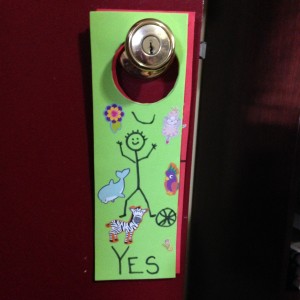How can your bedroom, your bathroom or the far end of your house help you get some quality free time away from your family and kids? Today I am going to share three experiments that women I have worked with have tried, with success, to get some quality free time.
Last week I gave you some tips for giving yourself some self-care right in the midst of your busy, sometimes chaotic family. However, now and then it is really important for mom’s and dad’s to have some down time from their family.
Remember what I said last week – Taking care of yourself does not make you selfish. It shows that you care about yourself and your family relationships. Being kind to yourself in everyday life is one of the best things you can do. Life will become lighter, and your relationships will most likely improve. You will feel happier overall. Your self-esteem will go up. You will be a better parent.
When I am mentoring parents, I frequently ask them to come up with experiments that they can try to get specific outcomes. I like the term experiment because it attaches nothing to the outcome. An experiment is just that, an experiment. You do it to see if you can get the desired result, but if you don’t, instead of beating yourself up for having another failure, you just try a new experiment. Here are three examples that had terrific results.
Experiment 1
 K was feeling burnt out. In one of our conversations, she told me about her wonderful bedroom. It had a lovely window seat that looked out onto a green field. The problem was that it was the messiest room in her home. So together we came up with a list of things that she could easily do to make it an inviting space.
K was feeling burnt out. In one of our conversations, she told me about her wonderful bedroom. It had a lovely window seat that looked out onto a green field. The problem was that it was the messiest room in her home. So together we came up with a list of things that she could easily do to make it an inviting space.
She cleared all the stuff off of the window seat and got a basket for her husband to put his stuff in – so it would stay cleaned off. She made some changes in how they managed the laundry, so it wasn’t always piled on the bed. She painted a wall. She added her favorite books to the window seat.
Then she talked with her family about her room and how it could help her be a better parent. She told them that when she feels like she is not going to be able to react the way she wants to, she was going to her bedroom to regroup, for 5-10 minutes. She asked for their support in allowing her to do this when she needs to. They all agreed to help her out.
When K is feeling on the verge of exploding or ceasing to be the adult, she retreats to her bedroom. She shuts the door and sits in the window seat for about 5 minutes. She breathes deeply, sometimes she reads one or two paragraphs in her book. Then she heads back out into the fray. She is managing better; her kids are happier, and her husband is relieved. : ) It has had a positive impact on her family.
Experiment 2
A has multiple heath issues that tax her strength and resources for parenting. She also has one child with some significant health issues. We talked about her getting some alone time twice a week. She worried that something might come up with her ill child and that her husband wouldn’t be able to handle it.
Nevertheless, she was willing to try an experiment. She asked her husband if he would take over for two hours a week, in the evening, so that she could write or paint. He was very open to the idea.
She decided on a room at the other end of the house from the family room where her husband and children would spend their time. That way she could have her quiet time and still be close at hand in case of an emergency.
The first week was a wonderful success. She was frankly impressed with her husband and was surprised that he managed so well without her. She was surprised that her kids managed so well without her.
She has been doing this for a while, now. It has given her husband an opportunity to be with the kids and she has been able to fulfill her need to write, paint, and have time to herself. The whole family is happier.
Experiment 3
 M wanted to know how I found time to read when I had so many children. She wants some time to be by herself and read. However, she has a large family, and her husband is often gone .
M wanted to know how I found time to read when I had so many children. She wants some time to be by herself and read. However, she has a large family, and her husband is often gone .
I took her on a visual walk through my bathroom. I have an amazing bathroom. I mentioned to her that it was my retreat. That surprised her, I mean really, the bathroom for your retreat. Who does that?
In my home, it is the only practical place. I live in a one bedroom apartment. The living room, office, and kitchen run the length of the house and are, for all intents and purposes just one room. The bedroom is right off of that part of the house, and you can hear the TV. The way the bathroom is situated make it a perfect alone space.
I talked to her about the simple things I have done to make it a sanctuary. Beautiful pictures are hanging on the wall. My favorite color is in the shower curtain and rugs. A vase of flowers and candles for decoration. Most importantly, a basket of wonderful books. Sometimes they just spill out of the basket. : )
Every time I go into the bathroom, which is at least three times a day, I read at least 1-3 paragraphs. You would be amazed at how much you can get read in a year 1-3 paragraphs at a time.
So M decided to give it a try. One of her worries was that her bathroom was always so messy. However, when she set about putting it to rights, she discovered that almost all of the clutter was hers. She devised some simple systems to keep her stuff corralled. She added some flowers, a new rug, and a basket of books.
At last report, she was enjoying her mini moments of peace and reading. It has made her feel more taken care of, and she is happier with her children.
When we are looking for alone time, we need to get creative. How can it be managed right where we are, without expending too much money or time? How can it be made doable even with small children? There is always a way to care for yourself right where you are.
Have you found some creative ways to manage your self-care? Please post your comments below. I would love to hear about them.
Possibly Related Posts:
- Self Care for Better Parenting – Part 1
- Got Kids 24/7 – 2 Tips to make life easier
- The Screen Free Experiment
- 5 Tips to Put Family first
- Our Stories Shape Our Lives – Part 2
{ 0 comments }












